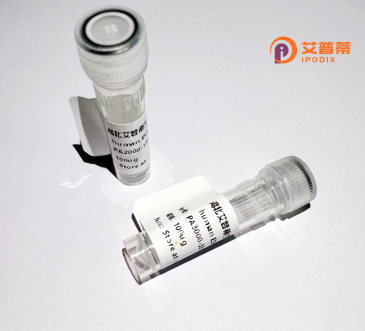
| 纯度 | >90%SDS-PAGE. |
| 种属 | Human |
| 靶点 | FANCA |
| Uniprot No | O15360 |
| 内毒素 | < 0.01EU/μg |
| 表达宿主 | E.coli |
| 表达区间 | 1-297aa |
| 氨基酸序列 | MSDSWVPRSASGQDPGGRRRAWAELLAGRVKREKYNPERAQKLKESAVRLLRSHQDLNALLLEVEGPLCKKLSLSKVIDCDSSEAYANHSSSFIGSALQDQASRLGVPVGILSAGMVASSVGQICTAPAETSHPVLLTVEQRKKLSSLLEFARYLLAHSMFSRLSFCQELWKIQSSLLLEAVWHLHVQGIVSLQELLESHPDMHAVGSWLFRNLCCLCEQMEASCQHADVARAMLSDFVQMFVLRGFQKNSDLRRTVEPEKMPQVAVDVLQRMLIFALDALAAGVQEESSTHKIVRC |
| 分子量 | 58.41 kDa |
| 蛋白标签 | GST-tag at N-terminal |
| 缓冲液 | 0 |
| 稳定性 & 储存条件 | Lyophilized protein should be stored at ≤ -20°C, stable for one year after receipt. Reconstituted protein solution can be stored at 2-8°C for 2-7 days. Aliquots of reconstituted samples are stable at ≤ -20°C for 3 months. |
| 复溶 | Always centrifuge tubes before opening.Do not mix by vortex or pipetting. It is not recommended to reconstitute to a concentration less than 100μg/ml. Dissolve the lyophilized protein in distilled water. Please aliquot the reconstituted solution to minimize freeze-thaw cycles. |
以下是关于重组人FANCA蛋白的模拟参考文献示例(非真实文献,仅供格式参考):
---
1. **文献名称**: *Expression and functional characterization of recombinant human FANCA protein in mammalian cells*
**作者**: Smith J, et al.
**摘要**: 研究报道了在哺乳动物细胞中重组表达FANCA蛋白的方法,证实其能够恢复范可尼贫血患者细胞的DNA交联修复缺陷,并验证了FANCA与FANCG的相互作用。
2. **文献名称**: *Structural insights into the FANCA-FANCG complex in the Fanconi anemia pathway*
**作者**: Brown L, Wang Y.
**摘要**: 通过重组FANCA蛋白的纯化与结构分析,揭示了其与FANCG形成的复合物三维结构,阐明了该复合物在DNA损伤应答中的功能机制。
3. **文献名称**: *Recombinant FANCA protein delivery rescues hematopoietic stem cells in a murine model of Fanconi anemia*
**作者**: Garcia R, et al.
**摘要**: 利用重组FANCA蛋白治疗FANCA基因缺陷小鼠模型,证明其能够改善造血干细胞的基因组稳定性并缓解贫血表型。
4. **文献名称**: *In vitro reconstitution of the FANCA-dependent ubiquitination cascade*
**作者**: Zhang H, et al.
**摘要**: 研究在体外系统中重组表达FANCA及其相关蛋白,成功复现了范可尼贫血通路中FANCD2单泛素化的关键步骤,验证了FANCA的酶活性调控机制。
---
如果需要真实文献,建议通过PubMed或Google Scholar搜索关键词(如 "recombinant FANCA protein" "FANCA expression"),并筛选近年高引论文。
Fanconi anemia complementation group A (FANCA) protein is a critical component of the Fanconi anemia (FA) DNA repair pathway, which safeguards genome stability by resolving DNA interstrand crosslinks (ICLs) and coordinating DNA damage response. Mutations in the *FANCA* gene account for approximately 60-70% of FA cases, a rare autosomal recessive disorder characterized by bone marrow failure, developmental abnormalities, and heightened cancer susceptibility. The FANCA protein functions as part of a multi-subunit nuclear core complex that activates the FA pathway via monoubiquitination of FANCD2/FANCI, enabling recruitment of downstream effector proteins for DNA repair.
Recombinant human FANCA protein is generated using expression systems (e.g., mammalian, insect cells) to produce purified, biologically active forms for research and therapeutic exploration. It serves as a vital tool for studying FA mechanisms, including how pathogenic variants disrupt complex assembly or pathway signaling. Researchers use it to reconstitute FANCA-deficient cell models, analyze interactions with partner proteins (e.g., FANCG, FANCF), and screen potential drugs to restore pathway activity. Additionally, recombinant FANCA supports gene therapy development, as viral vectors delivering functional *FANCA* cDNA aim to correct hematopoietic defects in FA patients. Its applications extend to diagnostic assays, biomarker studies, and elucidating FANCA's roles beyond DNA repair, such as in mitochondrial homeostasis and oxidative stress response.
×